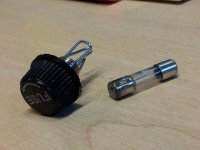Update:
The 3S batteries arrived 3 weeks after ordering them. Turnigy 30S 4000mAh ones. They seem fine.
First thing I noticed after connecting them all up with my various wiring harnesses was that the total pack voltage measured 36V. What the flip, I was expecting 60V! It turns out I had tried to serial together 48V and 12V with polarity reversed. I had the tips of my new parallel harness (for the 3S cells) round the wrong way. Pointy tip (on the 4mm bullets) should have been -ve and hollow tip +ve, as they are on the end of the bricks themselves. Can't help wondering why there wasn't a 'bang' when I connected them up wrong.
2nd thing I noticed was the top speed improvement. My best guess is that's its around 4 or 5 mph more (measured using GPS). Which is perfect for me. Top speed on the flat now 28-29mph. Possibly this would reach 30mph in warmer weather.
3rd thing I noticed was total loss of power 6 miles into my 15 mile commute. Fuse problems. Took out the fuse, noticed it was blackened but intact. Re-inserted and power returned. Cycled gingerly the rest of the way. Got to work, took the fuse out again, re-inserted and no power again. Confession time: it's a 20A fuse and the controller pulls 22A. It had been fine up till now (on 48V). Anyway, I fashioned a temporary one made from a paperclip to get me home:

Which worked. Fuse now replaced with a 30A one.
Also bought this for bulk charging: http://www.ebay.co.uk/itm/380507774625?ssPageName=STRK:MEWNX:IT&_trksid=p3984.m1439.l2649
Seems fine so far. Voltage and current adjustable.
So all good. Thanks again chaps, will report back if there are any interesting developments. Hopefully not though!


